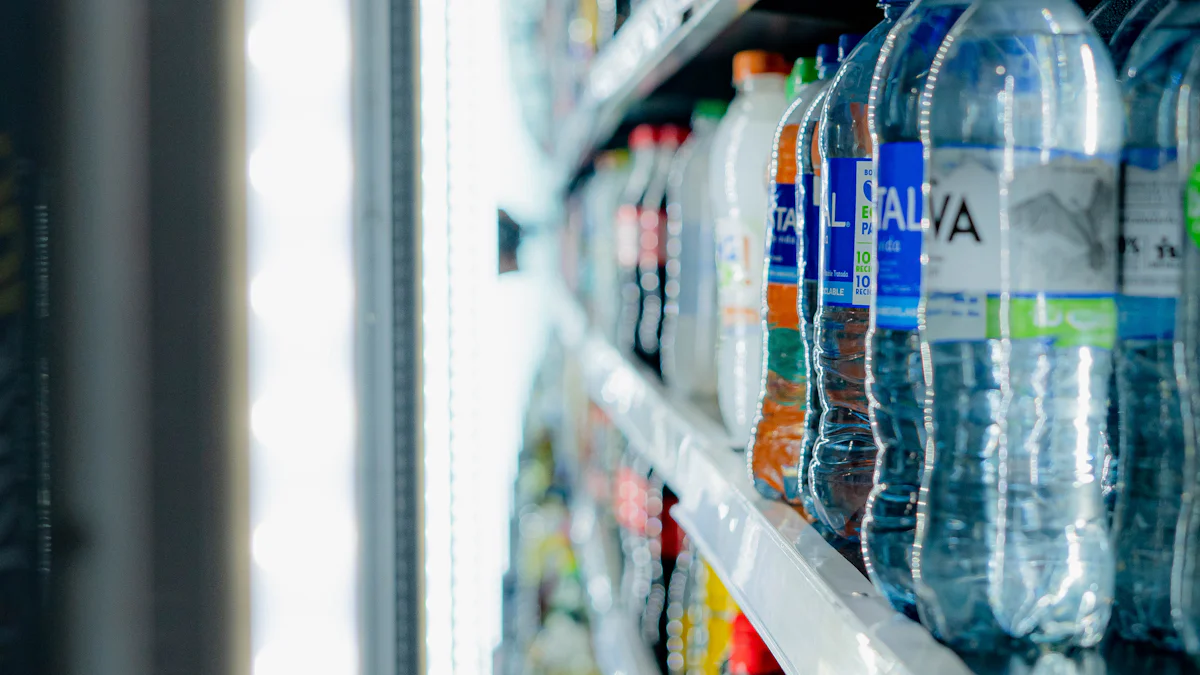How blast freezer tunnel settings save your food

Blast freezer tunnels revolutionise food preservation by freezing items at an accelerated pace. This rapid process locks in the food's natural texture, taste, and nutritional value. Unlike conventional freezing methods, it minimises the formation of large ice crystals, which can damage cellular structures. By maintaining extremely low temperatures, these tunnels effectively halt bacterial growth, ensuring the safety and longevity of frozen products. Businesses benefit from reduced wastage and compliance with food safety regulations. The ability to preserve food quality while extending shelf life makes blast freezer tunnels an indispensable tool in modern food storage.
What is a Blast Freezer Tunnel?

A blast freezer tunnel is a specialised freezing system designed to rapidly lower the temperature of food products. It achieves this by circulating extremely cold air at high speeds, ensuring quick and uniform cooling. This technology is widely used in industries such as food processing and pharmaceuticals, where preserving product quality and safety is critical. By freezing items at an accelerated pace, it prevents the formation of large ice crystals, which can damage the texture and structure of food. This makes it an essential tool for maintaining freshness and extending shelf life.
Purpose and Functionality of a Blast Freezer Tunnel
The primary purpose of a blast freezer tunnel is to freeze large quantities of food quickly and efficiently. Unlike standard freezers, which operate at slower cooling rates, these tunnels use powerful fans and advanced refrigeration systems to achieve rapid freezing. This process locks in the natural flavour, texture, and nutritional value of food.
Blast freezer tunnels are particularly effective for freezing cooked products directly after preparation, eliminating the need for pre-cooling. This ensures that food remains safe for consumption while reducing the risk of bacterial growth. Additionally, they support operational efficiency by enabling businesses to process and store food in bulk without compromising quality.
How a Blast Freezer Tunnel Differs from a Standard Freezer
A blast freezer tunnel differs significantly from a standard freezer in terms of speed, temperature, and functionality. Standard freezers typically operate at temperatures around 0°C and rely on static cooling methods. In contrast, blast freezer tunnels can reach temperatures as low as -30°C to -40°C or even lower, depending on the model. This extreme cold, combined with high-velocity air circulation, allows for rapid freezing.
Another key difference lies in their application. While standard freezers are suitable for long-term storage, blast freezer tunnels are designed for quick freezing, making them ideal for commercial and industrial use. They also minimise ice crystal formation, which helps preserve the quality of delicate items like seafood, fruits, and baked goods.
Key Features of a Blast Freezer Tunnel
Blast freezer tunnels come equipped with several advanced features that set them apart from conventional freezing systems:
High-Powered Fans: These circulate cold air evenly, ensuring consistent freezing across all products.
Advanced Temperature Control: Precise settings allow users to adapt the freezing process to different food types.
Rapid Cooling Technology: The ability to reduce the temperature of food from +70°C to -18°C within a few hours ensures maximum efficiency.
Energy Efficiency: Modern designs incorporate insulation and energy-saving mechanisms to reduce operational costs.
Versatility: Available in various configurations, such as continuous (tunnel), spiral, and rack systems, to suit different industrial needs.
These features make blast freezer tunnels indispensable for businesses aiming to maintain high standards of food safety and quality.
The Role of Temperature in Blast Freezer Tunnels
Temperature plays a critical role in the effectiveness of a blast freezer tunnel. By rapidly lowering the temperature of food products, this technology ensures safety, quality, and longevity. The precise control of temperature settings is essential for achieving optimal results in food preservation.
Why Temperature Matters in Food Preservation
Temperature directly impacts the preservation of food by influencing microbial activity and structural integrity. At higher temperatures, bacteria multiply rapidly, leading to spoilage and potential health risks. Blast freezing halts this process by exposing food to extremely cold air, typically between -10°C and -50°C. This rapid cooling prevents bacteria from thriving, ensuring food remains safe for consumption.
Moreover, temperature affects the physical properties of food. Slow freezing methods often result in the formation of large ice crystals, which damage the texture and flavour of food. Blast freezing, on the other hand, creates small ice crystals that preserve the original structure and taste. This makes it an ideal solution for maintaining the quality of delicate items such as seafood, fruits, and baked goods.
"Blast freezing is a way to quickly keep food safe from bacteria and preserve taste and nutritional value. It involves pushing very cold air over food products to freeze them rapidly."
The Ideal Temperature Range for Blast Freezing
The success of blast freezing depends on maintaining the correct temperature range. Most blast freezer tunnels operate within a range of -30°C to -40°C, although some advanced systems can reach temperatures as low as -50°C. This range ensures that food products are frozen quickly and uniformly, reducing the risk of uneven cooling.
For food safety, the core temperature of products must be brought down to -18°C or lower. This threshold effectively halts bacterial growth and extends the shelf life of frozen items. By adhering to this temperature range, businesses can ensure compliance with food safety standards while preserving the nutritional value of their products.
How Temperature Settings Prevent Ice Crystal Formation
Ice crystal formation is a common challenge in food freezing. Large crystals, which form during slow freezing, can rupture cell walls and degrade the texture of food. Blast freezer tunnels address this issue by rapidly lowering the temperature, minimising the time food spends in the critical freezing zone where large crystals form.
The high-speed circulation of cold air in a blast freezer tunnel ensures that food freezes uniformly and quickly. This process creates small ice crystals, which maintain the structural integrity of the food. As a result, the texture, flavour, and nutritional content remain intact, even after thawing.
By optimising temperature settings, blast freezer tunnels provide a reliable solution for preserving food quality. This technology not only enhances the appearance and taste of frozen products but also supports sustainable food storage practices by reducing waste.
Benefits of Using a Blast Freezer Cold Room

Maintaining Food Quality and Texture
A blast freezer cold room ensures that food retains its original quality by freezing it rapidly. This process prevents the formation of large ice crystals, which can damage the texture of products like seafood, fresh fish, and frozen meat. By maintaining the structural integrity of the food, the cold room preserves its natural taste and appearance. For instance, frozen fish stored in a blast freezer cold room remains as firm and flavourful as fresh fish when thawed. This technology is particularly beneficial for delicate items such as seafood, where maintaining freshness is critical.
The rapid freezing process also locks in nutrients, ensuring that frozen products retain their nutritional value. Unlike traditional freezers, which freeze food slowly, a blast freezer cold room minimises the time food spends in the critical temperature range where ice crystals form. This makes it an ideal solution for preserving the texture and flavour of fresh meat and other perishable items.
Extending Shelf Life and Reducing Waste
Blast freezer cold rooms play a vital role in extending the shelf life of food products. By rapidly lowering the core temperature of items to -18°C or below, they halt bacterial growth and slow down spoilage. This capability is especially valuable for businesses handling large quantities of perishable goods, such as frozen meat and seafood. Extended shelf life allows manufacturers and distributors to store products for longer periods without compromising quality.
Reducing waste is another significant advantage. Food that would otherwise spoil due to inadequate storage conditions can be preserved effectively in a blast freezer cold room. For example, surplus fresh meat can be frozen quickly, preventing it from going to waste. This not only benefits businesses by improving profit margins but also supports sustainable practices by minimising food wastage.
"Blast freezing is a cost-effective method that extends shelf life while reducing the likelihood of bacterial growth, making it an essential tool for food preservation."
Ensuring Food Safety Through Rapid Freezing
Food safety is a top priority in the storage and distribution of perishable goods. A blast freezer cold room ensures safety by rapidly freezing food, thereby minimising the time it spends in the temperature danger zone (5°C to 60°C). This zone is where bacteria multiply most rapidly, posing a risk to consumer health. By quickly reducing the temperature of food from 70°C to -18°C, the cold room effectively halts microbial activity.
This rapid freezing process is particularly crucial for high-risk items such as seafood and meat. For instance, frozen meat stored in a blast freezer cold room remains safe for consumption over extended periods. The technology also ensures uniform freezing, eliminating the risk of uneven cooling that could compromise food safety. Businesses can rely on this method to meet stringent food safety standards while maintaining the freshness and quality of their products.
Optimising Temperature Settings for Efficiency
Efficient temperature management in a blast freezer tunnel is essential for preserving food quality while reducing operational costs. Properly optimising these settings ensures that the freezing process remains effective and energy-efficient. By monitoring, adjusting, and tailoring the temperature to specific food types, businesses can increase efficiency and maintain high standards of food preservation.
Monitoring and Adjusting Temperature Settings
Regular monitoring of temperature settings is crucial for maintaining the performance of a blast freezer. Accurate temperature control ensures that food freezes uniformly, preventing spoilage and maintaining quality. Advanced temperature sensors and control systems allow operators to track fluctuations and make necessary adjustments in real time.
Frequent checks help identify inconsistencies in cooling performance. For instance, uneven temperature distribution can lead to partially frozen products, compromising their safety and texture. By addressing such issues promptly, businesses can avoid wastage and ensure compliance with food safety standards. Automated systems, equipped with alarms, further enhance monitoring by alerting operators to deviations from the desired temperature range.
Balancing Energy Efficiency with Cost Savings
Optimising temperature settings not only preserves food but also reduces energy consumption. Lowering the temperature quickly minimises the time required for freezing, which directly impacts energy usage. Efficient cooling processes enable businesses to process larger quantities of food in less time, leading to significant cost savings.
Energy-efficient practices, such as maintaining proper insulation and calibrating equipment regularly, further enhance performance. Modern blast freezers incorporate energy-saving technologies, such as variable-speed fans, which adjust airflow based on the cooling requirements. These innovations reduce operational costs without compromising the quality of frozen products.
"The faster lower temperatures can be achieved, the more product can be processed quickly, resulting in production efficiency and energy cost savings."
By balancing energy efficiency with cost savings, businesses can achieve sustainable operations while maintaining high standards of food preservation.
Adapting Settings for Different Food Types
Different food types require specific temperature settings to ensure optimal freezing. For example, seafood and fruits are more delicate and benefit from rapid freezing at lower temperatures, while baked goods may require slightly higher settings to maintain their texture. Customising the temperature for each product type prevents over-freezing or under-freezing, preserving the food's quality and nutritional value.
Operators must consider factors such as the size, moisture content, and composition of the food when adjusting settings. Advanced blast freezer systems offer programmable options, allowing users to set precise temperatures for various products. This adaptability ensures that all items are frozen efficiently, regardless of their unique characteristics.
Tailoring temperature settings to different food types not only enhances product quality but also supports operational efficiency. Businesses can optimise their freezing processes to meet diverse storage needs, ensuring consistent results across all product categories.
Common Challenges in Blast Freezer Tunnels
Inconsistent Temperature Distribution
Inconsistent temperature distribution poses a significant challenge in blast freezer tunnels. Uneven cooling can result in some food items freezing inadequately, which compromises their quality and safety. This issue often arises due to improper airflow within the freezer. High-powered fans in blast freezers are designed to circulate cold air evenly, but obstructions or poor maintenance can disrupt this process.
Operators must ensure that food is arranged correctly to allow optimal airflow. Overloading the freezer or stacking items improperly can block air circulation, leading to uneven freezing. Regular inspections of the system help identify and resolve such issues. Advanced blast freezer models now include sensors that monitor temperature variations, enabling operators to address inconsistencies promptly.
"Proper airflow management is crucial for maintaining consistent freezing and ensuring food safety."
By addressing uneven temperature distribution, businesses can maintain the integrity of frozen products and comply with food safety standards.
Equipment Maintenance and Calibration
Equipment maintenance and calibration are essential for the efficient operation of blast freezer tunnels. Over time, wear and tear can affect the performance of components such as fans, compressors, and temperature sensors. Neglecting maintenance can lead to reduced cooling efficiency and increased energy consumption.
Routine maintenance schedules should include cleaning, lubrication, and inspection of all critical parts. Dust and debris can accumulate on fans and coils, reducing their effectiveness. Regular cleaning ensures that the freezer operates at peak performance. Calibration of temperature sensors is equally important. Accurate sensors ensure that the freezer maintains the required temperature for rapid freezing, preventing spoilage and bacterial growth.
"Well-maintained equipment not only enhances performance but also extends the lifespan of the blast freezer."
Investing in professional servicing and training staff to handle minor repairs can minimise downtime and improve operational efficiency.
Managing High Energy Costs
Blast freezer tunnels consume significant amounts of energy due to their rapid cooling capabilities. Managing these high energy costs is a common challenge for businesses. Inefficient systems or improper usage can further escalate expenses, impacting profitability.
Energy-efficient practices can help mitigate these costs. Proper insulation of the freezer prevents cold air from escaping, reducing the workload on the refrigeration system. Modern blast freezers incorporate energy-saving technologies, such as variable-speed fans and advanced compressors, which optimise energy usage. Regular maintenance also plays a role in energy efficiency by ensuring that all components function correctly.
Operators can monitor energy consumption using smart systems that provide real-time data. These systems allow businesses to identify inefficiencies and make adjustments to reduce costs. Training staff on best practices, such as avoiding frequent door openings, also contributes to energy savings.
"Energy-efficient operations not only reduce costs but also support sustainable business practices."
By adopting these measures, businesses can manage energy costs effectively while maintaining high standards of food preservation.
Practical Tips for Maintaining Optimal Temperature Settings
Regular Maintenance and Cleaning of the Blast Freezer
Regular maintenance ensures that a blast freezer operates efficiently and maintains consistent temperature settings. Dust and debris often accumulate on fans, coils, and other components, reducing their effectiveness. Cleaning these parts prevents airflow obstructions and ensures uniform cooling. Operators should schedule routine inspections to identify wear and tear on critical components like compressors and temperature sensors.
Proper lubrication of moving parts also enhances performance and extends the lifespan of the equipment. Neglecting maintenance can lead to uneven temperature distribution, which compromises food quality and safety. Industry professionals emphasise that well-maintained equipment not only improves operational efficiency but also reduces energy consumption.
"Well-maintained blast freezers ensure consistent performance, reduce energy costs, and preserve food quality," say experts in the food industry.
By prioritising regular cleaning and maintenance, businesses can avoid costly repairs and ensure compliance with food safety standards.
Training Staff on Proper Usage and Monitoring
Staff training plays a pivotal role in maintaining optimal temperature settings. Employees must understand how to operate the blast freezer correctly and monitor its performance. Proper training ensures that staff can identify and address issues such as temperature fluctuations or airflow blockages promptly.
Operators should educate employees on the importance of arranging food items to optimise airflow. Overloading the freezer or improper stacking can disrupt air circulation, leading to inconsistent freezing. Training should also cover the use of advanced temperature control systems, enabling staff to make precise adjustments based on the type of food being frozen.
"Operators are key to ensuring efficient blast freezing by optimising airflow and monitoring temperature settings," highlight industry professionals.
Investing in staff training not only enhances operational efficiency but also minimises the risk of errors that could compromise food safety.
Investing in Advanced Temperature Control Systems
Advanced temperature control systems provide businesses with greater precision and flexibility in managing blast freezer settings. These systems use sensors to monitor temperature fluctuations in real time, allowing operators to make immediate adjustments. Automated alerts notify staff of any deviations from the desired temperature range, ensuring quick responses to potential issues.
Modern systems also offer programmable options, enabling businesses to customise settings for different food types. For example, seafood may require rapid freezing at lower temperatures, while baked goods might need slightly higher settings. This adaptability ensures that all products are frozen efficiently and retain their quality.
Energy-efficient technologies, such as variable-speed fans and advanced compressors, further enhance the performance of blast freezers. These innovations reduce energy consumption while maintaining consistent cooling. Industry experts note that investing in such systems not only improves food preservation but also supports sustainable business practices.
"Advanced temperature control systems are indispensable for ensuring food safety, reducing energy costs, and maintaining product quality," according to professionals in the field.
By adopting these technologies, businesses can optimise their freezing processes, reduce operational costs, and maintain high standards of food safety.
Comparing Blast Freezer Tunnels and Blast Freezer Cold Rooms
Key Differences in Design and Functionality
Blast freezer tunnels and blast freezer cold rooms serve distinct purposes in food preservation. A blast freezer tunnel is designed for rapid freezing, utilising high-velocity cold air to lower the temperature of food products quickly. This process minimises the formation of large ice crystals, preserving the texture and quality of delicate items like seafood and fruits. In contrast, a blast freezer cold room is better suited for long-term storage, maintaining a consistent low temperature to keep frozen products safe over extended periods.
The design of a blast freezer tunnel focuses on speed and efficiency. It incorporates powerful fans and advanced refrigeration systems to freeze food within hours, making it ideal for industries requiring quick processing. On the other hand, cold rooms are larger, static spaces that prioritise storage capacity over freezing speed. They are often used after the initial blast freezing process to store products until distribution or consumption.
"Blast freezers freeze products much quicker than cold rooms, reducing freezing time significantly," according to industry experts. This distinction highlights the complementary roles of these systems in food preservation.
Choosing the Right System for Your Needs
Selecting between a blast freezer tunnel and a blast freezer cold room depends on specific operational requirements. Businesses that handle perishable goods requiring immediate freezing, such as seafood or baked goods, benefit from the rapid cooling capabilities of a blast freezer tunnel. This system ensures that food retains its quality and nutritional value by freezing it quickly and uniformly.
For operations focused on long-term storage, a blast freezer cold room offers a more practical solution. It provides a stable environment for maintaining frozen products over weeks or months. This makes it suitable for businesses dealing with bulk storage, such as frozen meat distributors or large-scale food manufacturers.
When deciding, consider factors such as the volume of food processed, the required freezing speed, and the intended storage duration. Combining both systems can optimise food preservation, with the tunnel handling rapid freezing and the cold room ensuring safe storage.
Cost and Efficiency Considerations
Cost and efficiency play crucial roles in determining the suitability of these systems. A blast freezer tunnel, with its advanced technology and rapid freezing capabilities, often involves higher initial investment and operational costs. However, its ability to process large quantities of food quickly can lead to significant savings in time and reduced spoilage, making it cost-effective for high-volume operations.
Blast freezer cold rooms, while less expensive to operate, are not as energy-efficient when used for rapid freezing. Their strength lies in maintaining consistent temperatures for extended periods, which consumes less energy compared to the high-powered fans and compressors of a tunnel system. Businesses must weigh the energy costs against the benefits of preserving food quality and reducing waste.
"Cold rooms are beneficial for long-term freezing and reducing wastage," as noted by professionals in the field. This makes them an economical choice for businesses prioritising storage over speed.
By evaluating operational needs and budget constraints, businesses can choose the system that aligns best with their goals. A strategic combination of both systems often delivers the most efficient and cost-effective results.
Blast freezer tunnels play a crucial role in preserving food quality and safety. By rapidly freezing food, they prevent spoilage and maintain the texture, flavour, and nutritional value of products. This technology ensures that frozen items, such as meat, retain their original quality while extending their shelf life. Businesses benefit from reduced wastage and compliance with food safety regulations. Optimising temperature settings enhances efficiency, lowers operational costs, and supports sustainable practices. The ability to freeze food quickly and uniformly makes blast freezers indispensable for industries handling large quantities of perishable goods.
See Also
The Impact of Cryogenic Freezers on Food Quality
Unveiling the Advantages of Tunnel Freezing Technology
Tunnel Freezers: Solutions to Freezing Challenges

